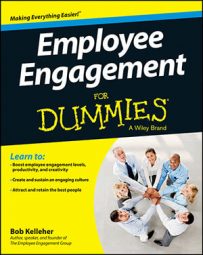Money is not always a primary engagement driver for employees — although the perception of unfairness or an organizational caste system (in which there are clear “haves” and “have nots”) is certain to lead to disengagement. Purpose, however, is an engagement driver. Indeed, organizations that build their cultures around purpose generally have higher levels of engagement than those that don't.
These companies are in on a powerful secret: Companies that know their own purpose, values, vision, and strategic plan (their “line of sight”), and that believe in corporate social responsibility, are better positioned to win over the hearts and minds of their employees. And not surprisingly, employees who are duly won over are significantly more likely to be engaged.
As a shining example of employee engagement, the Four Seasons hotel is renowned for its service culture. This is underscored by its mission statement, which includes the following components:
What we believe: Our greatest asset, and the key to our success, is our people. We believe that each of us needs a sense of dignity, pride, and satisfaction in what we do. Because satisfying our guests depends on the united efforts of many, we are most effective when we work together cooperatively, respecting each other's contribution and importance.
How we behave: We demonstrate our beliefs most meaningfully in the way we treat each other and by the example we set for one another. In all our interactions with our guests, customers, business associates, and colleagues, we seek to deal with others as we would have them deal with us.
In other words, the Four Seasons has been very successful in building a “line of sight” between its mission statement and the behaviors of its employees.
For organizations to develop a “line of sight,” they must answer the following questions:
Why do we exist (purpose)?
Who are we (values)?
Where are we going (vision)?
How will we get there (strategic plan)?
In addition, organizations must assess how they are doing — in other words, develop a scorecard of sorts.
How does building this “line of sight” boost engagement? Simple. It all has to do with aligning your organization with its purpose. When people care deeply about something, or are invested in an activity, cause, or job — intellectually and emotionally — they're generally more passionate about the outcome than when they are not invested.
If you don't believe me, consider people who donate their time to their community food kitchen, their church, local youth sports organizations, or charities. Do they get paid? No. So, why do they do it? Why do they invest time and energy in something that doesn't pay the mortgage? They do it because it has a purpose. It's a higher calling.
As an aside, just as it's important to create a company-level line of sight, it's also critical to create a personal-level one — that is, to help individuals develop a clear picture of where they are today in their careers and where they're going. You want employees to understand the company's strategic plan, and to know where they fit in that plan.

